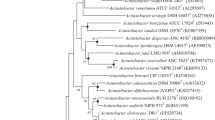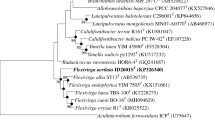Abstract
A diesel-oil and n-hexadecane-degrading novel bacterial strain, designated DR1T, was isolated from a rice paddy in Deok-So, South Korea. The strain DR1T cells were Gram-negative, aerobic coccobacilli, and grew at 20–37°C with the optimal temperature of 30°C, and an optimal pH of 6–8. Interestingly, strain DR1T was highly motile (swimming and swarming motility) using its fimbriae, and generated N-acyl homoserine lactones as quorum-sensing signals. The predominant respiratory quinone as identified as ubiquinone-9 (Q-9) and DNA G+C content was 41.4 mol%. Comparative 16S rRNA gene sequence-based phylogenetic analysis placed the strain in a clade with the species A. calcoaceticus, A. haemolyticus, A. baumannii, A. baylyi, and A. beijerinckii, with which it evidenced sequence similarities of 98.2%, 97.4%, 97.2%, 97.1%, and 97.0%, respectively. DNA-DNA hybridization values between strain DR1T and other Acinetobacter spp. were all less than 20%. The physiological and taxonomic characteristics with the DNA-DNA hybridization data supported the identification of strain DR1T in the genus Acinetobacter as a novel species, for which the name Acinetobacter oleivorans sp. nov. is proposed. The type strain is DR1T (=KCTC 23045T =JCM 16667T).
Similar content being viewed by others
References
Baker, J. and H. Maxted. 1975. Observations on the growth and movement of Acinetobacter on semi-solid media. J. Med. Microbiol. 8, 443–446.
Chun, J., J.H. Lee, Y. Jung, M. Kim, S. Kim, B.K. Kim, and Y.W. Lim. 2007. EzTaxon: a web-based tool for the identification of prokaryotes based on 16S ribosomal RNA gene sequences. Int. J. Syst. Evol. Microbiol. 57, 2259–2261.
Fischer, R., F.S. Bleichrodt, and U.C. Gerischer. 2008. Aromatic degradative pathways in Acinetobacter baylyi underlie carbon catabolite repression. Microbiology 154, 3095–3103.
Gonzalez, R.H., A. Nusblat, and B.C. Nudel. 2001. Detection and characterization of quorum sensing signal molecules in Acinetobacter strains. Microbiol. Res. 155, 271–277.
Jung, J. and W. Park. 2010. Complete genome sequence of the diesel-degrading Acinetobacter sp. strain DR1. J. Bacteriol. 192, 4794–4795.
Kang, Y.S., J. Kim, H.D. Shin, Y.D. Nam, J.W. Bae, C.O. Jeon, and W. Park. 2007. Methylobacterium platani sp. nov., isolated from a leaf of the tree Platanus orientalis. Int. J. Syst. Evol. Microbiol. 57, 2849–2853.
Kang, Y.S. and W. Park. 2010a. Protection against diesel oil toxicity by sodium chloride-induced exopolysaccharides in Acinetobacter sp. strain DR1. J. Biosci. Bioeng. 109, 118–123.
Kang, Y.S. and W. Park. 2010b. Trade-off between antibiotic resistance and biological fitness in Acinetobacter sp. strain DR1. Environ. Microbiol. 12, 1304–1318.
Kim, M.K., W.T. Im, H. Ohta, M. Lee, and S.T. Lee. 2005. Sphingopyxis granuli sp. nov., a β-glucosidase-producing bacterium in the family Sphingomonadaceae in α-4 subclass of the Proteobacteria. J. Microbiol. 43, 152–157.
Lawrence, R.C., T.F. Fryer, and B. Reiter. 1967. The production and characterization of lipase from a Micrococcus and a Pseudomonad. J. Gen. Microbiol. 48, 401–418.
Mesbah, M., U. Premachandran, and W.B. Whitman. 1989. Precise measurement of the G+C content of deoxyribonucleic acid by high-performance liquid chromatography. Int. J. Syst. Bacteriol. 39, 159–167.
Nemec, A., M. Musílek, O. Šedo, T. De Baere, M. Maixnerová, T.J.K. van der Reijden, Z. Zdráhal, M. Vaneechoutte, and L. Dijkshoorn. 2009a. Acinetobacter berezinae sp. nov. and Acinetobacter guillouiae sp. nov., to accommodate, respectively, Acinetobacter genomic species 110 and Acinetobacter genomic species 11. Int. J. Syst. Evol. Microbiol. doi:10.1099/ijs.0.013656-0.
Nemec, A., M. Musilek, M. Maixnerova, T. De Baere, T.J.K. van der Reijden, M. Vaneechoutte, and L. Dijkshoorn. 2009b. Acinetobacter beijerinckii sp. nov. and Acinetobacter gyllenbergii sp. nov., haemolytic organisms isolated from humans. Int. J. Syst. Evol. Microbiol. 59, 118–124.
Niu, C., K.M. Clemmer, R.A. Bonomo, and P.N. Rather. 2008. Isolation and characterization of an autoinducer synthase from Acinetobacter baumannii. J. Bacteriol. 190, 3386–3392.
Rosenberg, M., D. Gutnik, and E. Rosenberg. 1980. Adherence of bacteria to hydrocarbons: a simple method for measuring cell surface hydrophobicity. FEMS Microbiol. Lett. 9, 29–33.
Sarkar, S. and R. Chakraborty. 2008. Quorum sensing in metal tolerance of Acinetobacter junii BB1A is associated with biofilm production. FEMS Microbiol. Lett. 282, 160–165.
Sasser, M. 1990. Identification of bacteria by gas chromatography of cellular fatty acids. MIDI Inc., Newark, DE, USA.
Stackebrandt, E. and B.M. Goebel. 1994. Taxonomic note: a place for DNA-DNA reassociation and 16S rRNA sequence analysis in the present species definition in bacteriology. Int. J. Syst. Bacteriol. 44, 846–849.
Stanier, R.Y., N.J. Palleroni, and M. Doudoroff. 1966. The aerobic pseudomonads: a taxonomic study. J. Gen. Microbiol. 43, 159–271.
Throne-Holst, M., S. Markussen, A. Winnberg, T.E. Ellingsen, H.K. Kotlar, and S.B. Zotchev. 2006. Utilization of n-alkanes by a newly isolated strain of Acinetobacter venetianus: the role of two AlkB-type alkane hydroxylases. Appl. Microbiol. Biotechnol. 72, 353–360.
Throne-Holst, M., A. Wentzel, T.E. Ellingsen, H.K. Kotlar, and S.B. Zotchev. 2007. Identification of novel genes involved in long-chain n-alkane degradation by Acinetobacter sp. strain DSM 17874. Appl. Environ. Microbiol. 73, 3327–3332.
Vaneechoutte, M., I. Tjernberg, F. Baldi, M. Pepi, R. Fani, E.R. Sullivan, J. van der Toorn, and L. Dijkshoorn. 1999. Oil-degrading Acinetobacter strain RAG-1 and strains described as ‘Acinetobacter venetianus sp. nov.’ belong to the same genomic species. Res. Microbiol. 150, 69–73.
Wayne, L.G., D.J. Brenner, R.R. Colwell, P.A.D. Grimont, O. Kandler, M. Krichevsky, L.H. Moore, W.E.C. Moore, R.G.E. Murray, E. Stackebrandt, M.P. Starr, and H.G. Truper 1987. International Committee on Systematic Bacteriology. Report of the ad hoc committee on reconciliation of approaches to bacterial systematics. Int. J. Syst. Bacteriol. 37, 463–464.
Author information
Authors and Affiliations
Corresponding author
Additional information
These authors contributed equally to this work.
Supplemental material for this article may be found at http://www.springer.com/content/120956
Electronic supplementary material
Rights and permissions
About this article
Cite this article
Kang, YS., Jung, J., Jeon, C.O. et al. Acinetobacter oleivorans sp. nov. Is capable of adhering to and growing on diesel-oil. J Microbiol. 49, 29–34 (2011). https://doi.org/10.1007/s12275-011-0315-y
Received:
Accepted:
Published:
Issue Date:
DOI: https://doi.org/10.1007/s12275-011-0315-y




